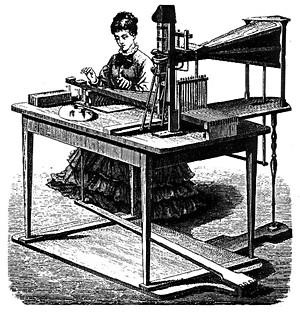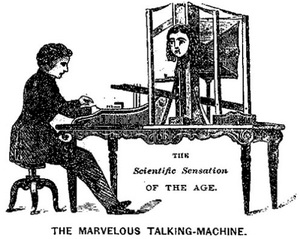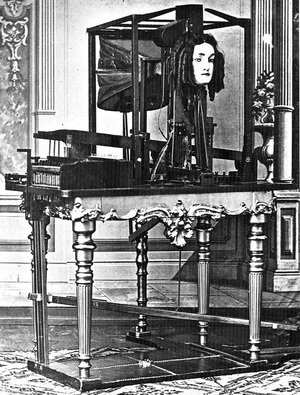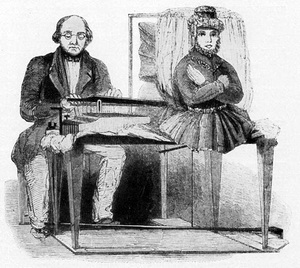|
Not Mr. Edison's Talking Machine
by Arthur E. Zimmerman and Betty Minaker Pratt

|
|
Shown is a female operator at the keyboard of Faberís "Euphonia", a mechanical
speech synthesizer that spoke through moving lips in a sepulchrous, creepy monotone
and inspired Bellís work toward his telephone.
|
|
|
There are talking machines, and then there
are machines that talk. Perhaps the first
known use of the term "talking machine"
in the U.S.A. was in the Quincy, Illinois,
Herald in 1844 (1), to describe Joseph Faberís
mechanical speech synthesizer that was played
with a keyboard and foot-pedals, like an organ.
Possibly the later uses of the term by Edison and
The Victor were appropriated from Faberís well-known
contrivance.
There had been much earlier attempts to fabricate
devices that could approximate human speech.
The natural philosopher and bishop Albertus
Magnus (c. 1206-1280) constructed a head
that moved and spoke, but his former pupil,
St. Thomas Aquinas, destroyed or hid it as an
abomination and a blasphemous challenge of
the Divine Order. Roger Bacon (1214-1294), an
English monk and the inventor of eyeglasses, is
also supposed to have made such a contraption
and in the 1770s Abbť Michal in Paris, Friedrich
von Knaus in Austria and a Mr. Kratzenstein
in St. Petersburg demonstrated their speaking
machines. Baron Wolfgang von Kempelen devised
a sort of talking pipe-organ (1769-91), which was
improved upon by the British electrical pioneer
Sir Charles Wheatstone (1802-75), but Faberís
"Euphonia" was deemed much better.
We stumbled upon the "Euphonia" story in
The Liberal of Richmond Hill, Ontario, June
17, 1886 (2), describing the demonstration of an
apparatus mounted on a gilt table, involving a
bellows for lungs, an artificial larynx, teeth, a
tongue and moving lips of black India rubber
mounted in a face mask, controlled by a keyboard
and able to say "mama", "papa" and an assortment
of female names.

|
|
"The Marvelous Talkng Machine": Probably the second Prof. Faber
(husband of Joseph Seniorís niece) at the keyboard, operating the
"Euphonia".
("Illustrated History of Wild Animals and
Other Curiosities Contained in P.T. Barnumís Great Travelling Worldís
Fair...." by William C. Crum, Wynkoop & Hallenbeck, New York, 1874)
|
|
|
At the end of the show, the
"Euphonia" said, in a doleful, monotonous
tone, "Iím very tired. Thank you, gentlemen.
Adieu". This report is anachronistic because, by
1886, Edisonís Perfected Phonograph had been
demonstrated and improved and the "Euphonia"
and all of its bits and pieces had disappeared from
history.
The story is sketchy, with variants, but it looks
as if Joseph Faber (c. 1800 - 1860s) was born
at Freiburg im Breisgau near the Black Forest,
studied at the Polytechnic in Vienna, most
interested in mathematics, astronomy and music.
While convalescing from an illness, doing woodcarving,
he read von Kempelenís work (3), went
back home and spent years building his prototype
of the speaking machine. He showed it in Vienna
in 1840 and to the King of Bavaria in 1841 (4),
but it excited little interest. He emigrated to the
United States (5), showed his invention in New
York City in 1844 (6) and then in Philadelphia,
where scientist and Director of the U.S. Mint
Robert M. Patterson saw it and was impressed.
Patterson even spoke about the machine to the
American Philosophical Society in May, 1844
and tried to raise financial backing for Faber (6)
but, discouraged, Faber destroyed his machine.
Patterson then accompanied fellow-scientist
Joseph Henry to Faberís workshop where he was
re-assembling his talking automaton, this time
with a female face. Henry was greatly impressed,
thought it superior to Wheatstoneís talking
figure (7) and encouraged Faber to demonstrate
its capabilities at the Musical Fund Hall in
Philadelphia in December, 1845. That showing
was another failure.

|
|
A photographer from the Mathew Brady studio, possibly Mathewís
nephew, captured an image of Joseph Faberís "Euphonia" at
Barnumís Museum in New York, circa 1860.
|
|
|
Around this time, Phineas T. Barnum, looking for
a fresh novelty, named the speaking automaton
"Euphonia" and took Faber to London (6, 9, 10),
where he showed the machine at the Egyptian
Hall in 1846. The "Euphonia" got the admiration
of the Duke of Wellington and satirizing by
Thackeray in Punch (11). Thackeray opined that
assistants could henceforth key-out pastorsí
weekly sermons for the congregations and that
Scottish parliamentariansí speeches could finally
be understood through the "Euphonia". Joseph
Henry and later Faber conjectured connecting
a "Euphonia" at either end of Samuel Morseís
marvel to give the world a talking telegraph.
It turns out that Melville Bell also saw the
"Euphonia" in London and that later influenced
Melville and his son Alexander Graham in their
work on speech synthesis.
The "Euphonia" actually worked. Witnesses said
that it had a "hoarse, sepulchral voice...as if from
the depths of a tomb" and some thought that there
had to be a small person hidden somewhere inside
it. In London, the "Euphonia" sang "God Save
the Queen" in its other-worldly flat voice. The
Illustrated London News was most impressed (10),
reporting that "The automaton is figured like a
Turk, the size of life, and of kit-cat proportions
(i.e. half-length portrait), reclining against some
pillows. Every portion of the machine is, however,
thrown open to the inspection of the company,
and its framework is moved about the room".
They noted that, since Faber was a German, "the
figure converses more fluently in that language
than in our own, but it is equally capable of
speaking French, English, Latin, Greek, and even
whispering, laughing and singing".
People remarked that they could even feel the
breath of the "Euphonia" emanating from the
India rubber lips set into a "stoney-eyed" mask
of a female face, but that was because the basic
driver of the apparatus was a large bellows
operated by a foot-pedal. The compressed air
was driven through a collection of reeds, whistles
and whoopie-cushion-type resonators, modified
by various shutters and baffles, and these were
controlled individually or in concert by a board
of 16 or 17 keys or levers.

|
|
Inventor Joseph Faber Senior, operating his speaking automaton from
the keyboard like an organ. The early model was arranged to look like
the face and torso of a Turk, a reference to another of Baron Wolfgang
von Kempelenís contraptions, a famous chess-playing figure. The latter
was a hoax, so the public was very suspicious of Faberís machine,
looking for a person hidden in the open framework or a speaking tube
through the floor.
("Illustrated London NewsĒ, August 1846)
|
|
|
The 16 or 17 elemental
sounds could be combined to sound out words
and phrases. The Liberal revealed that "the letters
represented on the keyboard were A, O, U, I, E, L,
R, W, F, S, Sh, B, G, and these were declared by
the professor to be all that was necessary, with the
judicious opening and closing of the rubber lips
to produce all combinations of sounds known to
the phonetic economy" (2). The speaking was, not
surprisingly, slow and deliberate.
Faber was described as a sad-faced be-spectacled
man, gloomy and taciturn, dressed in respectable
well-worn clothes that bore signs of the
workshop....not too clean, and his hair and beard
"sadly wanted the attention of a barber" (9).
After taking Faber to London for the Egyptian
Hall exhibition, Barnum showed it at his
American Museum of curiosities in New York
City, where Mathew Bradyís studio photographed
it, c. 1860, and later in his touring circus.
Faberís talking machine was still being shown in
Barnumís Circus when it played the Exhibition
Grounds on Grenville Street in Toronto in August
1874. The Toronto Mail (12) noted large crowds
around the machine, but observed that it must
have had a cold or a dislocated jaw because all of
its words sounded monotonous and similar.
A retrospective in The London Times in 1880
(4), said that Faber worked on his apparatus from
1815 to 1841, latterly with his nephew Joseph
Faber, demonstrated it to the King of Bavaria
and then died (by suicide in the 1850s or 1860s),
bequeathing it to his nephew. Altick said that it
was the husband of Faberís niece who toured
with the "Euphonia", calling himself Professor
Faber (13).

|
|
The 1846 "Punch" cartoon, showing the radical Tory MP Lord
George Bentinck, who had previously spoken very little in Parliament,
making the "Euphonia" finally address the House for him, though still
through Benjamin Disraeliís face.
|
|
|
In 1887, The New York Times reported that
Professor Faberís wife, Mrs. Mary Faber who
had operated the keyboard in years of touring,
threatened with eviction, attempted suicide in
her New York City apartment by taking the
insecticide Paris Green (14). Drifting in and out of
consciousness, she indicated a satchel containing
the "Euphonia" and wanted it sold to pay the rent.
It turns out, however, that this Mary Faber was
45 years old in 1887, too young to be Joseph Sr.ís
wife, so it is not clear whether this Mrs. Mary
Faber was Joseph Seniorís wife or his niece.
Around 1863, perhaps reminded of the
"Euphonia", phoneticist Melville Bell took young
Alexander Graham to meet Wheatstone, who
showed the Bells his contraption, and A.G. and
his brother built their own speaking automaton.
It had nasal cavities, a larynx, a soft palate and
a laterally articulating tongue. This experiment
in speech mechanics and his interest in teaching
the deaf eventually led to A.G.ís shifting from
mechanical to electrical technology, to his
"harmonic telegraph"and thence to the telephone.
Faberís "Euphonia" did not excite much interest
among theologians but the clergy flocked to see
and hear the results of Edisonís further shifting
of technology, continuing to be shocked and
appalled that a mortal aspired to re-create a basic
element of the sacred human spirit and violate the
Divine Order. To be fair, however, it was Faberís
machine that could synthesize the human voice,
whereas Edisonís tin-foil impious contraption
would speak only if addressed first, and then quite
firmly.
General Sources
- Quincy, Illinois Herald, February 9, 1844.
- "A Talking Machine" in The Liberal of Richmond Hill, Ontario, June 17, 1886, p. 6.
- Kempelen, Baron Wolfgang Ritter von, "On the Mechanism of Human Speech", Vienna, 1791.
- "Talking Machine", London Times, February 12, 1880.
- "Biography of Joseph Faber Senior, Inventor of the 'Euphonia' Talking Machine, in Phonozoic Text Archive, Document 094.
- "Talking Head" by David Lindsay in The Magazine of Invention, vol.12 #3, Winter 1997, and Talking Head.
- "Joseph Henry and the Telephone" in The Joseph Henry Papers Project by Frank Rives Millikan.
- "Joseph Faber and the Amazing Talking Machine', in The Peerless Prodigies of P.T. Barnum".
- "Joseph Faber's Talking Euphonia"in Irrational Geographic.
- "The Euphonia, or Speaking Automaton", Illustrated London News, July 25, 1846, p. 59.
- "The Speaking Machine", attrib to Thackeray, Punch, July-Dec. 1846, p. 64.
- "Barnum's Circus", The Toronto Mail, August 4, 1874, p. 4.
- "Shows of London" by Richard D. Altick (Harvard Univ. Press, 1978, p. 356).
- "The Talking Machine Was There", The New York Times, July 24, 1887, page 9 - 6.
Thanks to Brenda Hicock, M.L.I.S. City of
Vaughan Archives.
|